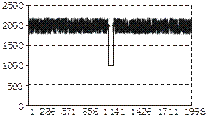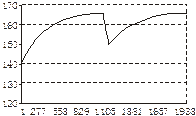We know the effect calories have on your body.For each pound of weight that your body carries,it takes about 12 calories per pound per day to keep it alive.If you weigh 150 pounds,you therefore need about (150×12) 1800 calories per day to keep yourself alive and maintain that same weight.
If you were to eat more than 1800 calories per day,the surplus turns into fat.It takes about 3600 excess calories to make a pound of fat.Let's say that you were to eat,on average,2000 calories per day.That extra 200 calories per day is going to turn into fat.However,you will eventually hit a point of equilibrium(平衡,均衡) because as you gain weight,you need more calories to maintain that weight.So,a person eating an average of 2000 calories per day will hit equilibrium at (2000/12) 166.67 pounds.
So let's say that you eat,on average,2000 calories per day and reach equilibrium at 166 pounds.Then you go on a crash diet where you eat only 1000 calories per day for 60 days.You lose 16 pounds and reach your target weight of 150 pounds.But then you go right back to eating 2000 calories per day again.The graph below shows your eating pattern before,during and after the diet:

Note that the graph assumes that you,like most people,eat a random number of calories per day.Some days you are “good” and eat less,and some days you are “bad” and eat more,but the assumption is that it averages out to 2000 calories per day over the long run.
This graph shows what happens to your weight before,during and after the diet:

The diet really takes the weight off.But the weight comes right back when you return to your “normal” eating pattern.The weight appears to come back so quickly because when you are at your lightest,you tend to gain more weight each day.The lighter you are,the fewer calories you need.If you only need 1500 calories per day and you're eating 2000,you're going to gain weight faster than if you need 1800 and you're eating 2000.
小题1:The passage is mainly about_________.
| A.how to lose weight effectively |
| B.why the weight comes back so quickly once a person stops dieting |
| C.why a person puts on weight |
| D.how to keep a healthy diet |
小题2:According to the text,a person weighing 120 pounds needs _________calories per day to keep the same weight.
小题3:Suppose all the following people take in 3000 calories every day.Who will gain weight fastest?
| A.A person who weighs 200 pounds. | B.A person who weighs 180 pounds. |
| C.A person who weighs 150 pounds. | D.A person who weighs 100 pounds. |
小题4:What will the writer continue to discuss at the end of the text?
| A.Ways to keep the weight off. | B.Ways to go on a diet. |
| C.Diseases caused by overweight. | D.Proper diet to keep healthy. |